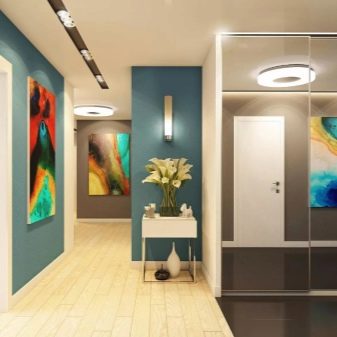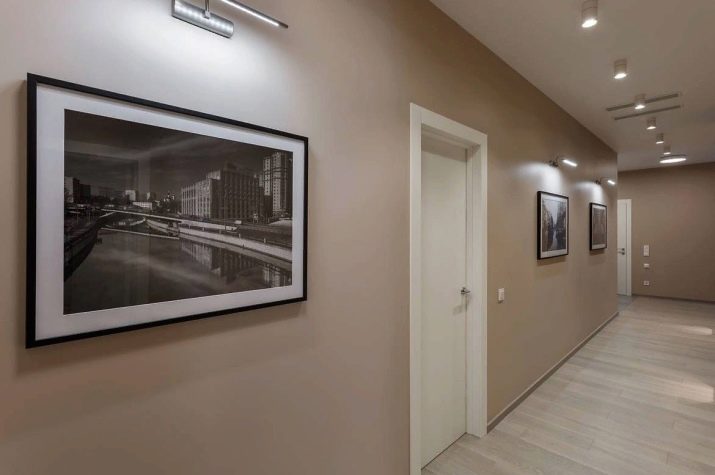How to decorate a wall in a hallway?

Knowing how to decorate a wall in a hallway is very important for owners of apartments and private houses. It is useful to figure out in advance how to decorate the wall in the corridor. Additionally, you need to study options for decor made of wood and with laminate, with mirror tiles and with stone, the use of art objects and other ideas.




Decoration principles
Quite often you have to solve typical design tasks. For example, how to decorate white walls in the hallway that look too dull and dull. Of course, white or another light color expands the space and makes it visually advantageous. However, you still need to fill in an unnecessarily empty surface. It will look unnatural in itself.

One of the good options for decorating the walls in the hallway is to use wallpaper. Their technical and visual variety allows a very original decorative effect to be achieved at a relatively low cost.
It should be borne in mind that it is not always necessary to even glue the canvases with your own hands. It is a good idea to place them between plastic panels or in a frame.
The size of the frames is chosen according to your taste, it is especially good to beat beautiful and original patterns on the wallpaper.



One nuance must be taken into account: hanging carpets on the walls is categorically unacceptable. This is not only old-fashioned, not only does it not fit into modern standards, but also simply ridiculous, has no practical and design benefit. Sometimes the question arises - is it possible to use purple paint for the walls or other bright, juicy colors.These solutions are only acceptable in large enough rooms. With a small area of the corridor, they are perceived as pretentious, unnatural and can even create serious aesthetic problems.


Each powerful, saturated color can only be used in one case:
- when the task that he must solve is clearly stated;
- when there is an understanding of all the consequences caused by this decision;
- when the composition is generally balanced.


The choice of design options for a long narrow room has its own subtleties. Long-term practice of designers has made it possible to develop several of the most popular and relevant ways out of this situation. First of all, it is necessary to rearrange the furniture, and ideally, replace it with light samples. It is also useful to play with the texture of the walls, with the textures of materials. Other possible solutions:
- addition of decorative architectural elements;
- highlighting visual zones;
- maximum lightening of the problematic side of the room.


Finally, there are nuances and decoration of the wall opposite the door. The floor is made darker than the walls. The use of glossy and mirror surfaces is encouraged. It is useful to apply something catchy, some kind of solution that immediately grabs attention. However, too pretentious design is contraindicated here.




Using luminaires
Whatever materials are used for the walls in an apartment or in a private house, whatever original design solutions are found, everything will be in vain if they are poorly visible. Therefore, it is very important to use elegant lighting fixtures.
However, it is not their appearance that is decisive, but the characteristics of the glow.
A cramped room should be decorated with lamps with warm bright radiation. Cool light is more acceptable in larger rooms.




Experts also advise using several different types of lighting devices to illuminate large spaces at once. The main thing is that they fit into a single style. When choosing minimalistic design options, you need flat luminaires with a circular or upward luminous flux. Sometimes they put sconces - they can even become one of the main decorative items. If we talk about spots, then this is just a very convenient option, which is recommended if there are no other preferences and requirements.


Here are some more tips:
- in rooms of a modern style, it is worth using miniature lamps;
- take into account the peculiarities of the propagation of light in a particular room;
- calculate in advance the connection points and power supply lines;
- pay attention to the shape of the shades, lampshades, to the colors of the main parts.

Decorative accents
It was recommended to use laminate for wall decoration in rooms several years ago. But during this time it became clear that such a step is not always appropriate. Rather, it emphasizes the pursuit of austerity rather than originality of thought. In classic interiors, wood decor is much more appropriate. It can look both elegant and with a hint of closeness to nature, to rural life - depending on what motives are used.


It is possible to use elite wood species only on a limited basis, in small areas. Otherwise, the costs are prohibitive. It is easy for lovers of natural styles to save money - you just have to use saw cuts, branches and other waste material. In some cases, you can also use a natural or artificial stone with a matte or glossy surface. This option looks very attractive on accent walls.

You can also use:
- mirror tiles;
- polymer panels;
- paint (however, simple paint looks dull and expressionless);
- decorative plaster;
- bamboo wallpaper;
- ceramic tiles;
- composite three-dimensional panels.


Art objects
The usual options offered by builders and architects are not to the liking of all customers.Skillful use of art objects allows you to successfully solve this problem even in the most difficult cases. A very good classic solution is to use black and white photographs. They must be selected carefully and with analysis so that the decor fits into the intended composition. Other possible options:
- shelves of a non-standard shape (for example, in the form of a triangle) - they are also functional;

- bright and juicy vinyl stickers;

- "Heart" from family or favorite photos;

- an elegant craft made of branches and sticks;

- stylized clock from pipes.

Beautiful examples of the interior
The combination looks very good:
- masonry (or imitation);

- original lamps with multi-beam radiation;

- light yellow monotone background surface for luminaires.

You can also consider options such as:
- graceful figured imitation of stone or brickwork, complemented by plant motifs;

- white brick finish;

- curly white surface with a complex texture;

- a combination of white and blue walls (on the latter it is still worth hanging pictures);

- original curly tiles.









